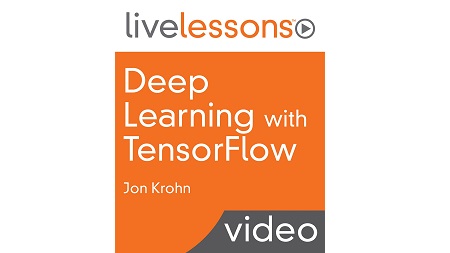
English | MP4 | AVC 1280×720 | AAC 44KHz 2ch | 7h 19m | 4.78 GB
An intuitive, application-focused introduction to deep learning and TensorFlow, Keras, and PyTorch
Deep Learning with TensorFlow, Keras, and PyTorch LiveLessons is an introduction to deep learning that brings the revolutionary machine-learning approach to life with interactive demos from the most popular deep learning library, TensorFlow, and its high-level API, Keras, as well as the hot new library PyTorch. Essential theory is whiteboarded to provide an intuitive understanding of deep learning’s underlying foundations; i.e., artificial neural networks. Paired with tips for overcoming common pitfalls and hands-on code run-throughs provided in Python-based Jupyter notebooks, this foundational knowledge empowers individuals with no previous understanding of neural networks to build powerful state-of-the-art deep learning models.
Learn How To
- Build deep learning models in all the major libraries: TensorFlow, Keras, and PyTorch
- Understand the language and theory of artificial neural networks
- Excel across a broad range of computational problems including machine vision, natural language processing, and reinforcement learning
- Create algorithms with state-of-the-art performance by fine-tuning model architectures
- Self-direct and complete your own Deep Learning projects
Lesson 1: Introduction to Deep Learning and Artificial Intelligence
The first lesson starts off by giving the viewer an overview of what neural networks are, how they’re related to machine learning (ML) and artificial intelligence (AI), as well as the breadth of transformative applications deep learning has supplied. Subsequently, Jon leverages visual analogies to describe what deep learning is and why it’s a uniquely powerful approach. You use an interactive tool to observe for yourself in real-time how a deep learning network learns, and Jon goes over how to run the code examples he provides throughout these LiveLessons before building an introductory neural network with you.
Lesson 2: How Deep Learning Works
The lesson begins with a discussion of the main families of deep neural networks and their applications. The heart of the lesson is a high-level overview of the essential theory that underlies deep learning. To bring this theory to life, Jon shows you deep learning in action via a web application called the TensorFlow Playground. He introduces the archetypal deep learning data sets, and then you build a deep neural network together to tackle a classic machine vision problem.
Lesson 3: High-Performance Deep Learning Networks
The previous lesson covered the principal foundations of deep learning and enabled you to construct a deep network. This lesson builds upon those theoretical foundations by covering weight initialization, unstable gradients, batch normalization, how to avoid overfitting, and more sophisticated learning optimizers. This additional theory enables you to build a state-of-the-art deep learning model using TensorFlow’s Keras API. In addition, you and Jon tackle a regression problem with deep learning for the first time, having focused on classification problems only up until this point. In order to make sense of the outputs from these sophisticated models, the TensorBoard result-visualization tool is added to your arsenal at the end of the lesson.
Lesson 4: Convolutional Neural Networks
Up to this point you have relied exclusively on dense nets to solve the machine learning problems. In this lesson, you dig into the theory of convolutional layers and then stack them together with Keras in TensorFlow in order to build your first convolutional neural network. Jon wraps up the lesson by discussing model architectures.
Lesson 5: Moving Forward with Your Own Deep Learning Projects
In Lesson 5, Jon compares and contrasts all the leading Deep Learning libraries and provides detailed hands-on examples of how to use PyTorch – the hot new library on the block – to build deep learning models. He concludes these LiveLessons by providing a framework for optimally tuning any model’s hyperparameters before leaving you with advice on how to build your own deep learning project, including datasets and resources for further self-study.
Table of Contents
01 Deep Learning with TensorFlow, Keras, and PyTorch – Introduction
02 Topics
03 1.1 Neural Networks, Machine Learning, and Artificial Intelligence–Part 1
04 1.2 Neural Networks, Machine Learning, and Artificial Intelligence–Part 2
05 1.3 A Visual Introduction to Deep Learning–Part 1
06 1.4 A Visual Introduction to Deep Learning–Part 2
07 1.5 TensorFlow Playground–Visualizing a Deep Net in Action
08 1.6 Running the Hands-On Code Examples in Jupyter Notebooks
09 1.7 An Introductory Neural Network with TensorFlow and Keras–Part 1
10 1.8 An Introductory Neural Network with TensorFlow and Keras–Part 2
11 Topics
12 2.1 Neural Units–Part 1
13 2.2 Neural Units–Part 2
14 2.3 Neural Networks–Part 1
15 2.4 Neural Networks–Part 2
16 2.5 Training Deep Neural Networks–Part 1
17 2.6 Training Deep Neural Networks–Part 2
18 2.7 Training Deep Neural Networks–Part 3
19 2.8 An Intermediate Neural Net with TensorFlow and Keras
20 Topics
21 3.1 Weight Initialization
22 3.2 Unstable Gradients and Batch Normalization
23 3.3 Model Generalization–Avoiding Overfitting
24 3.4 Fancy Optimizers
25 3.5 A Deep Neural Net with TensorFlow and Keras
26 3.6 Regression Models
27 3.7 TensorBoard and the Interpretation of Model Outputs
28 Topics
29 4.1 Convolutional Layers
30 4.2 A ConvNet with TensorFlow and Keras
31 4.3 Machine Vision Applications
32 Topics
33 5.1 Comparison of the Leading Deep Learning Libraries
34 5.2 Deep Learning with PyTorch–Part 1
35 5.3 Deep Learning with PyTorch–Part 2
36 5.4 Hyperparameter Tuning
37 5.5 Datasets for Deep Learning and Resources for Self-Study
38 Deep Learning with TensorFlow, Keras, and PyTorch – Summary
Resolve the captcha to access the links!